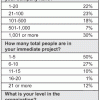Business Transformation Requires Transformational Leaders
Leadership and teaming skills are front and center in times of rapid change. Meet today’s constant disruption head on with expert guidance in leadership, business strategy, transformation, and innovation. Whether the disruption du jour is a digitally-driven upending of traditional business models, the pandemic-driven end to business as usual, or the change-driven challenge of staffing that meets your transformation plans—you’ll be prepared with cutting edge techniques and expert knowledge that enable strategic leadership.
Recently Published
The reasons why enterprises pursue systematic knowledge management (KM) are clear: they wish to make people -- and the whole enterprise -- act intelligently to operate more effectively and satisfy their stakeholders better. However, practical issues of how to approach, introduce, or expand KM practices are complex. When KM practices are implemented in an enterprise, the efforts become continual processes that will go on for years.
There has been a love-hate relationship between IT and performance measurement ever since IT emerged from the freight elevator, stumbled into the express elevator, emerged on the executive floor, and became a reluctant member of the business's management team. Accountability became the word of the day, along with budgets, controls, standards, and, eventually, key performance indicators (KPIs) and performance reporting.
Everyone has been complaining about Sarbanes-Oxley and other government-induced compliance formulae for several years now (everybody, of course, except the auditors and the consultants who make their money on compliance and related activities). Technology has become part of the compliance process in some very important ways. Let's talk about the role that IT governance plays in compliance and the frameworks out there to help us all stay legal.
Lean Risk Management
For one of my manufacturing clients, "lean" is in. This client analyzes ergonomics, steps taken, rework, and refit to an excruciating level of detail. In watching this, it has saved hundreds of resource hours on the shop floor and has rendered its organization more responsive and worker-friendly. Its environment makes more sense today from a work perspective than it did just six months earlier.
Driving RFID to the Bank
Radio frequency identification (RFID) technology now occupies that unenviable position all enterprise IT finds itself in at some point in its lifecycle. Born on the mountaintop of huge expectations, it fell into a canyon of disillusionment and confusion as companies were slower to utilize it than anticipated and that utilization has been less innovative than originally expected. Now, climbing out of the abyss into the light of hope, RFID is poised to see accelerated adoption over the next several years.
The Myth of the Mythical Business Case
Man is a measuring animal. Making a choice between alternatives requires sensing, thinking, and doing. Sometimes we need to decide within seconds; sometimes we have the luxury of time. It is clear that some people make better choices than others. But how should people decide?
Organizational Culture Is Important in Software Productivity
If you wanted to dramatically improve the productivity of a software development team, what would you do? Well, you might start by providing training to improve team members' skills; you might then improve the tools they work with; and finally, you might improve their software process. Is that all? Can you do anything else to make the team more productive?
The "Tune" at the Top: Corporate Liability for Workplace Use of P2P
Over the last few years, companies in the music and entertainment industries have repeatedly sued a host of businesses such as Napster, MP3.com, and others for contributory copyright infringement. The defendants in such cases typically provided software or sites that users could access to download or swap music, based on peer-to-peer (P2P) technology.








